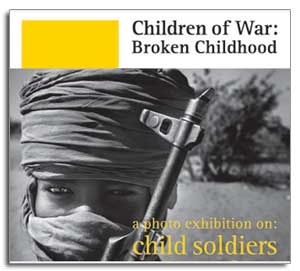 Recalling the motto of the Museum of Military History "Wars belong in Museums", Museum Director Christian Ortner warmly welcomed the assembled guests and speakers to the opening of the month-long exhibition "Children of War: Broken Childhood", organized in conjunction with UNIS Vienna. The exhibit was jointly produced by Leora Kahn of the NGO Proof: Media for Social Justice and the Office of the Special Representative of the Secretary General for Children and Armed Conflict. It was first shown in New York in 2008 and has since traveled to various locations, including Italy, Mexico and the Dominican Republic. This is the first time it is being shown in Austria. The objective of the exhibit is to sensitize member states, partners and the public at large on crimes against children in war affected zones, especially as regards the issue of child soldiers.
Recalling the motto of the Museum of Military History "Wars belong in Museums", Museum Director Christian Ortner warmly welcomed the assembled guests and speakers to the opening of the month-long exhibition "Children of War: Broken Childhood", organized in conjunction with UNIS Vienna. The exhibit was jointly produced by Leora Kahn of the NGO Proof: Media for Social Justice and the Office of the Special Representative of the Secretary General for Children and Armed Conflict. It was first shown in New York in 2008 and has since traveled to various locations, including Italy, Mexico and the Dominican Republic. This is the first time it is being shown in Austria. The objective of the exhibit is to sensitize member states, partners and the public at large on crimes against children in war affected zones, especially as regards the issue of child soldiers.
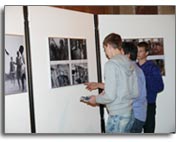 Currently, there are at least 250,000 child soldiers engaged in over 20 conflilcts worldwide; more than one billion children -- a sixth of the world's population -- live in countries or territories affected by armed conflict. War violates every right of the child. The changing nature of conflicts has meant that children are increasingly and disproportionately affected by conflict, both as actors and as victims. Girls are particularly vulnerable. 12 February has been designated as "Red Hand Day" - a day for commemoration and for awareness raising on the issue of child soldiers and the plight of children in armed conflict in general.
Currently, there are at least 250,000 child soldiers engaged in over 20 conflilcts worldwide; more than one billion children -- a sixth of the world's population -- live in countries or territories affected by armed conflict. War violates every right of the child. The changing nature of conflicts has meant that children are increasingly and disproportionately affected by conflict, both as actors and as victims. Girls are particularly vulnerable. 12 February has been designated as "Red Hand Day" - a day for commemoration and for awareness raising on the issue of child soldiers and the plight of children in armed conflict in general.
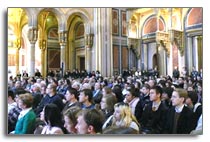 UNIS Vienna and the Museum of Military History joined forces to not only present this extremely moving exhibition to the broader Austrian public, but also to reach out to schools in particular. In a series of special guided tours and workshops that accompany the exhibit, pupils aged 15 - 19 have the possibility to learn about the plight of children in armed conflict throughout the centuries and gain a particularly vivid insight into what it means to be a child soldier. For two days, former child soldier John Kon Kelei from Sudan, who is now a driving force in the Network of Young People Affected by War (NYPAW) met with Austrian pupils to talk about his experiences and answer their questions. Recruited at the age of four, Kon received military training and was prepared for battle until he escaped at the age of ten. Now the holder of a Master's degree in international treaty law from a Dutch university, he has made it his life's calling to be a voice for child soldiers around the globe and to raise awareness of this barbaric breach of human rights.
UNIS Vienna and the Museum of Military History joined forces to not only present this extremely moving exhibition to the broader Austrian public, but also to reach out to schools in particular. In a series of special guided tours and workshops that accompany the exhibit, pupils aged 15 - 19 have the possibility to learn about the plight of children in armed conflict throughout the centuries and gain a particularly vivid insight into what it means to be a child soldier. For two days, former child soldier John Kon Kelei from Sudan, who is now a driving force in the Network of Young People Affected by War (NYPAW) met with Austrian pupils to talk about his experiences and answer their questions. Recruited at the age of four, Kon received military training and was prepared for battle until he escaped at the age of ten. Now the holder of a Master's degree in international treaty law from a Dutch university, he has made it his life's calling to be a voice for child soldiers around the globe and to raise awareness of this barbaric breach of human rights.
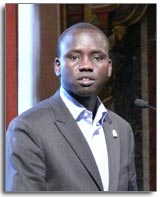 "I do not talk about my past because I like talking about it; I talk about it, because I have been fortunate and because I can speak out. I can be the voice for the 250,000 child soldiers who cannot speak for themselves," he said to a packed hall at the exhibition opening. The audience was visibly moved as Mr. Kelei asked all to stand in a minute's silence to remember the millions of children that suffer in armed conflicts around the globe. In her opening statement, UNODC human trafficking expert Riikka Puttonen gave an overview of the legal instruments at the dispopsal of the international community to address the issue of child soldiers and explained the links between human trafficking, smuggling in migrants and in small arms and the exploitation of minors - as soldiers, porters, as prostitutes and even as organ donors.
"I do not talk about my past because I like talking about it; I talk about it, because I have been fortunate and because I can speak out. I can be the voice for the 250,000 child soldiers who cannot speak for themselves," he said to a packed hall at the exhibition opening. The audience was visibly moved as Mr. Kelei asked all to stand in a minute's silence to remember the millions of children that suffer in armed conflicts around the globe. In her opening statement, UNODC human trafficking expert Riikka Puttonen gave an overview of the legal instruments at the dispopsal of the international community to address the issue of child soldiers and explained the links between human trafficking, smuggling in migrants and in small arms and the exploitation of minors - as soldiers, porters, as prostitutes and even as organ donors.
UNIS Director Maher Nasser said: "The stories told by this exhibition and the courageous journey of Kon Kelei, and others like him are another reason for us to harden our resolve to defend the rights of children and expose the crimes of those who exploit them." In his brief remarks, he highlighted some the achievements that had been made in recent years, such as the release of nearly 2,000 former child soldiers in Nepal only last week or Security Council resolution 1882 (2008) which was hailed at the time by the SRSG for Children and Armed Conflict Radhika Coomaraswamy as a major step forward in the fight against impunity for crimes against children and a recognition of the reality of conflict today.
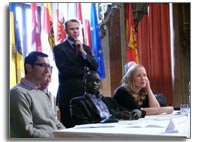 However, much still remains to be done, as the intervention by former DPKO child protection officer Massimo Toschi highlighted. In a passionate personal account he spoke of the dilemmas of peacekeepers in many missions who might find themselves confronted by twleve-year-olds wielding assault rifles. He spoke of the plight of children caught up the drug wars in the favelas of Latin America and of the absolute necessity comprehensively to tackle problems of poverty and development if the issue of child soldiers is to be properly addressed.
However, much still remains to be done, as the intervention by former DPKO child protection officer Massimo Toschi highlighted. In a passionate personal account he spoke of the dilemmas of peacekeepers in many missions who might find themselves confronted by twleve-year-olds wielding assault rifles. He spoke of the plight of children caught up the drug wars in the favelas of Latin America and of the absolute necessity comprehensively to tackle problems of poverty and development if the issue of child soldiers is to be properly addressed.
The exhibition and the accompanying school programme continue through 12 March and there are plans for the exhibition to be shown both at the Vienna International Centre and at other venues throughout Austria.
For more information, please see
www.un.org/children/conflict
www.unicef.org/protection/index.html
www.nypaw.org